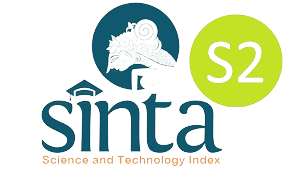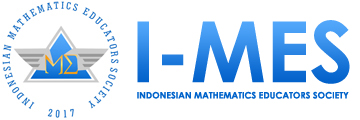Pedagogical scaffolding strategies for supporting students with mathematical learning difficulties in special education
DOI:
https://doi.org/10.29408/jel.v11i3.29996Keywords:
mathematics learning difficulties, scaffolding strategies, special schoolAbstract
Students with special needs, including those with speech impairments, often face challenges in learning mathematics and therefore require specialised strategies, such as scaffolding, to enhance their mathematical understanding. This study aimed to examine how scaffolding strategies support students with speech impairments in overcoming difficulties in learning mathematics in a special school setting. This qualitative case study involved one teacher and five students with speech impairments, selected through purposive sampling. Data were collected through observations, tests, interviews, and audio and video recordings. Data analysis was conducted in three stages: data reduction, data display, and conclusion drawing and verification. The findings show that the teacher’s scaffolding aligned with six aspects of the Mäkinen and Mäkinen framework: activation, presence, sensitivity, assistance, trust, and autonomy. Activation and assistance were the most strongly associated with improved conceptual understanding. The students demonstrated the ability to define, represent, and calculate the perimeter of squares and rectangles. Visual aids, concrete objects, and multimodal communication (oral, gestural, and sign language) enhanced understanding. Integrating visual, kinesthetic, and nonverbal strategies provides meaningful support for students with speech impairments, and the six-dimensional scaffolding framework serves as a practical guide for inclusive instructional design.
References
Anghileri, J. (2006). Scaffolding practices that enhance mathematics learning. Journal of Mathematics Teacher Education, 9(1), 33–52. https://doi.org/10.1007/s10857-006-9005-9
Ariza, J. Á., & Hernández Hernández, C. (2025). A systematic literature review of research-based interventions and strategies for students with disabilities in STEM and STEAM education. International Journal of Science and Mathematics Education, 1–31. https://doi.org/10.1007/s10763-025-10544-z
Ashqar, H. I., & Atawnih, A. (2025). Enhancing mathematics learning for hard-of-hearing students through real-time Palestinian sign language recognition: A new dataset. arXiv. https://doi.org/10.48550/arXiv.2505.17055
Byrne, E. M., Jensen, H., Thomsen, B. S., & Ramchandani, P. G. (2023). Educational interventions involving physical manipulatives for improving children's learning and development: A scoping review. Review of Education, 11(2), e3400. https://doi.org/10.1002/rev3.3400
Cagıltay, K., Cakır, H., Karasu, N., Islım, O. F., & Cıcek, F. (2019). Use of educational technology in special education: Perceptions of teachers. Participatory Educational Research, 6(2), 189–205. https://doi.org/10.17275/per.19.21.6.2
Faber, T. J., Dankbaar, M. E., van den Broek, W. W., Bruinink, L. J., Hogeveen, M., & van Merriënboer, J. J. (2024). Effects of adaptive scaffolding on performance, cognitive load and engagement in game-based learning: A randomized controlled trial. BMC Medical Education, 24, 943–960. https://doi.org/10.1186/s12909-024-05698-3
Fuchs, L. S., & Fuchs, D. (2002). Mathematical problem-solving profiles of students with mathematics disabilities with and without comorbid reading disabilities. Journal of Learning Disabilities, 35(6), 564–574. https://doi.org/10.1177/0022219402035006070
Hart, G., & Heathfield, E. (2017, July). Making math visible. In Proceedings of Bridges 2017: Mathematics, Art, Music, Architecture, Education, Culture (pp. 63–70). http://archive.bridgesmathart.org/2017/bridges2017-63.html
Herawati, A. A., & Anjany, F. (2025). Hambatan epistemologi siswa dalam pembelajaran geometri ditinjau dari gender dan resiliensi matematis [Students' epistemological barriers in learning geometry in terms of gender and mathematical resilience]. Jurnal Riset Pembelajaran Matematika, 7(1), 27–38. https://doi.org/10.55719/jrpm.v7i1.1536
Jannah, U. R., Saleh, H., & Wahidah, A. (2019). Scaffolding untuk pembelajaran matematika di kelas inklusi [Scaffolding for mathematics learning in inclusive classrooms]. JKPM (Jurnal Kajian Pendidikan Matematika), 5(1), 61–72. http://dx.doi.org/10.30998/jkpm.v5i1
Kementerian Pendidikan, Kebudayaan, Riset, dan Teknologi. (2023). Peraturan Menteri Pendidikan, Kebudayaan, Riset, dan Teknologi Nomor 48 Tahun 2023 tentang Akomodasi yang Layak untuk Peserta Didik Penyandang Disabilitas [Ministerial Regulation No. 48 of 2023 on Reasonable Accommodation for Students with Disabilities]. Kemdikbudristek.
Khan, S., & Krell, M. (2019). Scientific reasoning competencies: A case of preservice teacher education. Canadian Journal of Science, Mathematics and Technology Education, 19(4), 446–464. https://doi.org/10.1007/s42330-019-00063-9
Kooloos, J. G., Bergman, E. M., Scheffers, M. A., Schepens‐Franke, A. N., & Vorstenbosch, M. A. (2020). The effect of passive and active education methods applied in repetition activities on the retention of anatomical knowledge. Anatomical Sciences Education, 13(4), 458–466. https://doi.org/10.1002/ase.1924
Lim, L., Bannert, M., van der Graaf, J., Fan, Y., Rakovic, M., Singh, S., ... & Gašević, D. (2024). How do students learn with real‐time personalized scaffolds? British Journal of Educational Technology, 55(4), 1309–1327. https://doi.org/10.1111/bjet.13414
Lin, T., & Riccomini, P. (2025). Inclusive education in rural settings: Leveraging technology for improved math learning outcomes among students with disabilities. Journal of Special Education Technology, 40(2), 219–226. https://doi.org/10.1177/01626434241263045
Mäkinen, M., & Mäkinen, E. (2011). Teaching in inclusive setting: Towards collaborative scaffolding. La Nouvelle Revue de l'Adaptation et de la Scolarisation, 55(3), 57–74. https://doi.org/10.3917/nras.055.0057
Miles, M. B., Huberman, A. M., & Saldana, J. (2014). Qualitative data analysis: A methods sourcebook (3rd ed.). Sage Publications.
Munshi, A., Biswas, G., Baker, R., Ocumpaugh, J., Hutt, S., & Paquette, L. (2023). Analysing adaptive scaffolds that help students develop self‐regulated learning behaviours. Journal of Computer Assisted Learning, 39(2), 351–368. https://doi.org/10.1111/jcal.12761
Nardacchione, G., & Peconio, G. (2021). Peer tutoring and scaffolding principle for inclusive teaching. Elementa: Intersections Between Philosophy, Epistemology and Empirical Perspectives, 1(1–2), 181–200. https://doi.org/10.7358/elem-2021-0102-nape
National Council of Teachers of Mathematics. (2000). Principles and standards for school mathematics. NCTM.
Phutane, M., Wright, J., Castro, B. V., Shi, L., Stern, S. R., Lawson, H. M., & Azenkot, S. (2022). Tactile materials in practice: Understanding the experiences of teachers of the visually impaired. ACM Transactions on Accessible Computing, 15(3), 1–34. https://doi.org/10.1145/3508364
Prabaswara, A. A., & Pratama, F. W. (2023). Scaffolding to help numeracy literacy mild mental retardation children on the introduction of the value of money. Kreano: Jurnal Matematika Kreatif-Inovatif, 14(1), 190–201. https://doi.org/10.15294/kreano.v14i1.41190
Prystiananta, N. C., & Noviyanti, A. I. (2025). Enhancing EFL instruction in special needs education: Integrating multimodal digital tools and deep learning strategies. Voices of English Language Education Society, 9(1), 96–108. https://doi.org/10.29408/veles.v9i1.29411
Siller, H. S., Nitzan-Tamar, O., & Kohen, Z. (2023). Scaffolding practices for modelling instruction in STEM-related contexts: Insights from expert and novice teachers. ZDM–Mathematics Education, 55(7), 1351–1364. https://doi.org/10.1007/s11858-023-01529-9
Slavin, R. E. (2008). Cooperative learning: Teori, riset dan praktik [Cooperative learning: Theory, research, and practice]. Nusa Media.
Smith, C. M., & Juergensen, R. L. (2023). Virtual scaffolded instruction for students with disabilities. Journal of Special Education Technology, 38(1), 93–101. https://doi.org/10.1177/01626434211054433
Susilo, C. Y., & Prihatnani, E. (2022). Scaffolding for slow learner children on integer operations. Kreano: Jurnal Matematika Kreatif-Inovatif, 13(1), 113–125. https://doi.org/10.15294/kreano.v13i1.44031
Ukobizaba, F., Nizeyimana, G., & Mukuka, A. (2021). Assessment strategies for enhancing students’ mathematical problem-solving skills: A review of literature. Eurasia Journal of Mathematics, Science and Technology Education, 17(3), em1945. https://doi.org/10.29333/ejmste/9728
Wainscott, S. D., & Spurgin, K. (2024). Differentiating language for students who are deaf or hard of hearing: A practice-informed framework for auditory and visual supports. Language, Speech, and Hearing Services in Schools, 55(2), 473–494. https://doi.org/10.1044/2023_lshss-22-00088
Yantoro, Y., Kurniawan, D. A., Perdana, R., & Rivani, P. A. (2021). Process skills mathematics learning in elementary school. Jurnal Pendidikan dan Pengajaran, 54(3), 203–212. https://doi.org/10.23887/jpp.v54i3.37180
Young, A. R., Beitchman, J. H., Johnson, C., Douglas, L., Atkinson, L., Escobar, M., & Wilson, B. (2002). Young adult academic outcomes in a longitudinal sample of early identified language impaired and control children. Journal of Child Psychology and Psychiatry, 43(5), 635–645. https://doi.org/10.1111/1469-7610.00053
Downloads
Published
How to Cite
Issue
Section
License
Copyright (c) 2025 Melda Anggreni, Anwar, Said Munzir

This work is licensed under a Creative Commons Attribution-ShareAlike 4.0 International License.
Authors who publish with the Jurnal Elemen agree to the following terms:
- Authors retain copyright and grant the journal right of first publication with the work simultaneously licensed under Creative Commons Attribution-ShareAlike 4.0 International License (CC BY-SA 4.0).
- Authors are able to enter into separate, additional contractual arrangements for the distribution of the journal's published version of the work (e.g., post it to an institutional repository or publish it in a book), with an acknowledgment of its initial publication in this journal.
- Authors are permitted and encouraged to post their work online (e.g., in institutional repositories or on their website) prior to and during the submission process, as it can lead to productive exchanges, as well as earlier and greater citation of published work.
Jurnal Elemen is licensed under a Creative Commons Attribution-ShareAlike 4.0 International License





